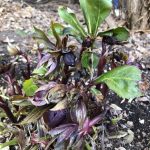The snowdrops are well up in my garden now, and the hellebore buds as well. Funny moment as I was raking leaves away from them this morning — an older gentleman said as he was passing, “Be careful — they’re going to hire you to do that for the whole neighborhood!” Heh. I admit, a little bit of me was tempted to say, “Fine with me!” It felt so good being out and working in the open air this morning. But I wouldn’t really want to garden full-time. I’m happier writing and teaching other people how to garden. ![]()
As you can see in the second photo, there are some snowdrops with very yellow leaves. Those are the ones that were smothered under a thick layer of redbud leaves — there was no way they’d be able to push through those, but now that they’re raked away, the yellow leaves should go green and they should straighten up and be just fine, like the others.
I’m thinking a lot these days about how to incorporate more eco-friendly practices into my garden, given that I still am the kind of gardener who delights in new varieties, showy blossoms, etc. It seems unlikely that I’ll ever go completely over to a purely native garden. I don’t plant invasive if I can help it, and I’m slowly removing the invasives I have already.
I’m also thinking of actually digging out some of my parkway strip this year, removing non-natives and replacing them with natives. My “Fairy” roses replaced with native roses — the website warns that native roses can be aggressive and aren’t suited for small gardens, but the parkway strip is contained, so perhaps they’d be okay there? (Advice welcome from those who know.)
And for the snowdrops — I originally had spotted them all over the garden, thinking it was charming to have little clumps all over. And it is. But it means I have no idea where they are, and I have to rake up all the leaf mould to uncover them, disturbing a host of overwintering pollinators. I’m thinking that this year, if time permits, I’m going to dig up the random clumps of snowdrops and move them to be near the hellebores. That way, I can use the hellebores (whose green leaves are visible in the leaf mould) as a marker — I can just rake carefully around them, uncover the snowdrops, and leave the rest of the garden alone.
That can apply more broadly to my other bulbs too, my daffodils and tulips etc. and so on. Keep them in certain sections (mostly bordering the path), and leave deep stretches of leaf-mould-covered garden for perennials, that will emerge slowly and have no trouble pushing through the leaves.
And then the leaves will have more time to break down and enrich the soil, continuing to transform what was once hard-packed clay into something rich and nutrient-dense. That’ll save me money too — I can skip putting down a layer of mushroom compost, and probably go lighter on the late spring mulching too.
It’ll take a little effort to shift over to that approach; once the snowdrops have bloomed, I’ll dig them up and move them while they’re still ‘in the green,’ to give them the best chance of surviving transplant. (Dig deep when moving bulbs, to try to avoid cutting the stalk away from the bulb itself — deeper for bigger bulbs that bloom later.)
I think in the long run, it’ll make for a much more pollinator-rich garden, which means, among other things, more flowers. Win-win.



